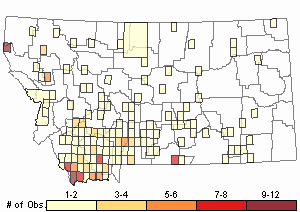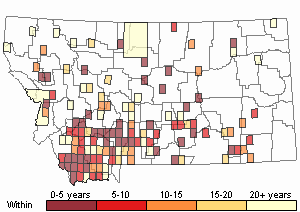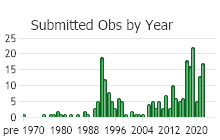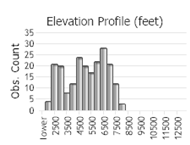View in other NatureServe Network Field Guides
NatureServe
Montana
Utah
Wyoming
Idaho
Wisconsin
British Columbia
South Carolina
Yukon
California
New York
Great Basin Wildrye - Elymus cinereus
Other Names:
Leymus cinereus
Native Species
Global Rank:
G5
State Rank:
S4
C-value:
5
Agency Status
USFWS:
USFS:
BLM:
External Links
General Description
Bunchgrass. Stems 1–2 m tall, forming large bunches or tussocks. Leaves: blades 7–12 mm wide, usually flat. Inflorescence 8–22 cm long, the rachis continuous and erect. Spikelets mostly 3 (sometimes more) per node, 11–15 mm long; glumes narrow, gradually tapering from the base to a narrow pointed tip, about as long as 1st lemma, veins not evident or with a single vein. Lemmas mostly 3 to 5 per spikelet, sparsely short hairy, awnless or with a short awn to 5 mm long (Lavin in
Lesica et al. 2012. Manual of Montana Vascular Plants. BRIT Press. Fort Worth, TX).
Species Range
Montana Range
Range Descriptions

 Native
Native
Range Comments
Mainly throughout much of the western half of North America (Lavin in Lesica et al. 2012. Manual of Montana Vascular Plants. BRIT Press. Fort Worth, TX).
Observations in Montana Natural Heritage Program Database
Number of Observations: 261
(Click on the following maps and charts to see full sized version)
Map Help and Descriptions
Relative Density

Recency



 (Observations spanning multiple months or years are excluded from time charts)
(Observations spanning multiple months or years are excluded from time charts)
Habitat
Open shrub steppe to open montane understory, in theory near seeps, as well as moderately disturbed sites such as along rural roads subject to little disturbance (e.g., grading, spraying, etc.). (Lavin in
Lesica et al. 2012. Manual of Montana Vascular Plants. BRIT Press. Fort Worth, TX).
References
- Literature Cited AboveLegend:
 View Online Publication
View Online Publication Lesica, P., M.T. Lavin, and P.F. Stickney. 2012. Manual of Montana Vascular Plants. Fort Worth, TX: BRIT Press. viii + 771 p.
Lesica, P., M.T. Lavin, and P.F. Stickney. 2012. Manual of Montana Vascular Plants. Fort Worth, TX: BRIT Press. viii + 771 p.
- Additional ReferencesLegend:
 View Online Publication
View Online Publication
Do you know of a citation we're missing? Ament, R.J. 1995. Pioneer Plant Communities Five Years After the 1988 Yellowstone Fires. M.Sc. Thesis. Bozeman, MT: Montana State University. 216 p.
Ament, R.J. 1995. Pioneer Plant Communities Five Years After the 1988 Yellowstone Fires. M.Sc. Thesis. Bozeman, MT: Montana State University. 216 p. Anderson, N.L. 1951. Field studies on the biology of range grasshoppers of southeastern Montana. M.Sc. Thesis. Bozeman, Montana: Montana State University. 96 p.
Anderson, N.L. 1951. Field studies on the biology of range grasshoppers of southeastern Montana. M.Sc. Thesis. Bozeman, Montana: Montana State University. 96 p. Blunt, K.R. 2001. Seasonal forage dry matter production and quality of 29 dryland grasses in Montana. M.Sc. Thesis. Bozeman MT: Montana State University. 174 p.
Blunt, K.R. 2001. Seasonal forage dry matter production and quality of 29 dryland grasses in Montana. M.Sc. Thesis. Bozeman MT: Montana State University. 174 p. Buckmaster, 2015. Community Composition Analysis of Altered Vegetation Communities Following the Release of Grazing Pressure. M.Sc. Thesis. Bozema, MT: Montana State University. 66 p.
Buckmaster, 2015. Community Composition Analysis of Altered Vegetation Communities Following the Release of Grazing Pressure. M.Sc. Thesis. Bozema, MT: Montana State University. 66 p. Culver, D.R. 1994. Floristic analysis of the Centennial Region, Montana. M.Sc. Thesis. Montana State University, Bozeman. 199 pp.
Culver, D.R. 1994. Floristic analysis of the Centennial Region, Montana. M.Sc. Thesis. Montana State University, Bozeman. 199 pp. Dillard, S.L. 2019. Restoring semi-arid lands with microtopography. M.Sc. Thesis. Bpzeman, MT: Montana State University. 97 p.
Dillard, S.L. 2019. Restoring semi-arid lands with microtopography. M.Sc. Thesis. Bpzeman, MT: Montana State University. 97 p. Eggers, M.J.S. 2005. Riparian vegetation of the Montana Yellowstone and cattle grazing impacts thereon. M.Sc. Thesis. Montana State University, Bozeman, MT. 125 p.
Eggers, M.J.S. 2005. Riparian vegetation of the Montana Yellowstone and cattle grazing impacts thereon. M.Sc. Thesis. Montana State University, Bozeman, MT. 125 p. Fischer, B.V. 2019. The Effects of increasing crop diversity on populations of Wheat Stem Sawfly (Cephus cinctus) and associated braconid parasitoids. M.Sc. Thesis. Bozeman, MT: Montana State University. 127 p.
Fischer, B.V. 2019. The Effects of increasing crop diversity on populations of Wheat Stem Sawfly (Cephus cinctus) and associated braconid parasitoids. M.Sc. Thesis. Bozeman, MT: Montana State University. 127 p. Fraas, W.W. 1992. Bitterbrush growth and reproductive character in relation to browsing in southwest Montana. M.Sc. Thesis. Bozeman, MT: Montana State University. 137 p.
Fraas, W.W. 1992. Bitterbrush growth and reproductive character in relation to browsing in southwest Montana. M.Sc. Thesis. Bozeman, MT: Montana State University. 137 p. Guenther, G.E. 1989. Ecological relationships of bitterbrush communities on the Mount Haggin Wildlife Management Area. M.Sc. Thesis. Bozeman, MT: Montana State University. 73 p.
Guenther, G.E. 1989. Ecological relationships of bitterbrush communities on the Mount Haggin Wildlife Management Area. M.Sc. Thesis. Bozeman, MT: Montana State University. 73 p. Hildebrand, B. D. 1979. Habitat requirements of molting Canada Geese at Lima Reservoir, Montana. M.Sc. Thesis. Bozeman, MT: Montana State University. 79 p.
Hildebrand, B. D. 1979. Habitat requirements of molting Canada Geese at Lima Reservoir, Montana. M.Sc. Thesis. Bozeman, MT: Montana State University. 79 p. Hodgson, J.R. 1970. Ecological distribution of Microtus montanus and Microtus pennsylvanicus in an area of geographic sympatry in southwestern Montana. Ph.D. Dissertation. Bozeman, Montana: Montana State University. 65 p.
Hodgson, J.R. 1970. Ecological distribution of Microtus montanus and Microtus pennsylvanicus in an area of geographic sympatry in southwestern Montana. Ph.D. Dissertation. Bozeman, Montana: Montana State University. 65 p. Hoffman, T.L. 1996. An ecological investigation of mountain big sagebrush in the Gardiner Basin. M.Sc. Thesis. Bozeman, MT: Montana State University. 84 p.
Hoffman, T.L. 1996. An ecological investigation of mountain big sagebrush in the Gardiner Basin. M.Sc. Thesis. Bozeman, MT: Montana State University. 84 p. King, L.A. 1980. Effects of topsoiling and other reclamation practices on nonseeded species establishment on surface mined land at Colstrip, Montana. M.Sc. Thesis. Bozeman, MT: Montana State University. 129 p.
King, L.A. 1980. Effects of topsoiling and other reclamation practices on nonseeded species establishment on surface mined land at Colstrip, Montana. M.Sc. Thesis. Bozeman, MT: Montana State University. 129 p. Kitchen, K.A. 2010. The influence of Douglas-fir and Rocky Mountain juniper on Wyoming and mountain big sagebrush cover in southwest Montana. M.Sc. Thesis. Bozeman, MT: Montana State University. 87 p.
Kitchen, K.A. 2010. The influence of Douglas-fir and Rocky Mountain juniper on Wyoming and mountain big sagebrush cover in southwest Montana. M.Sc. Thesis. Bozeman, MT: Montana State University. 87 p. Krall, J. L., J. R. Stroh, C. S. Cooper, and S. R. Chapman. 1971. Effect of time and extent of harvesting basin wild rye. J. Range Manage. 24(6):414-418.
Krall, J. L., J. R. Stroh, C. S. Cooper, and S. R. Chapman. 1971. Effect of time and extent of harvesting basin wild rye. J. Range Manage. 24(6):414-418. Lesica, P., M.T. Lavin, and P.F. Stickney. 2022. Manual of Montana Vascular Plants, Second Edition. Fort Worth, TX: BRIT Press. viii + 779 p.
Lesica, P., M.T. Lavin, and P.F. Stickney. 2022. Manual of Montana Vascular Plants, Second Edition. Fort Worth, TX: BRIT Press. viii + 779 p. Matlock-Cooley, S.J. 1993. Interaction between Deermice, Antelope Bitterbrush, and cattle in southwest Montana. M.Sc. Thesis. Bozeman, MT: Montana State University 84 p.
Matlock-Cooley, S.J. 1993. Interaction between Deermice, Antelope Bitterbrush, and cattle in southwest Montana. M.Sc. Thesis. Bozeman, MT: Montana State University 84 p. Meier, G.A. 1997. The colonization of Montana roadsides by native and exotic plants. M.Sc. Thesis. Bozeman, MT: Montana State University. 45 p.
Meier, G.A. 1997. The colonization of Montana roadsides by native and exotic plants. M.Sc. Thesis. Bozeman, MT: Montana State University. 45 p. Morris, M.S. and J.E. Schwartz. 1957. Mule deer and elk food habits on the National Bison Range. Journal of Wildlife Management 21(2):189-193.
Morris, M.S. and J.E. Schwartz. 1957. Mule deer and elk food habits on the National Bison Range. Journal of Wildlife Management 21(2):189-193. Nyberg, H.E. 1980. Distribution, movements and habitat use of mule deer associated with the Brackett Creek winter range, Bridger Mountains, Montana. M.Sc. Thesis. Bozeman, MT: Montana State University. 106 p.
Nyberg, H.E. 1980. Distribution, movements and habitat use of mule deer associated with the Brackett Creek winter range, Bridger Mountains, Montana. M.Sc. Thesis. Bozeman, MT: Montana State University. 106 p. O'Connor, K.S. 1987. Ecology of white-tailed deer and mule deer in agricultural lands in the Gallatin Valley, Montana. M.Sc. Thesis. Bozeman, MT: Montana State University. 67 p.
O'Connor, K.S. 1987. Ecology of white-tailed deer and mule deer in agricultural lands in the Gallatin Valley, Montana. M.Sc. Thesis. Bozeman, MT: Montana State University. 67 p. Quire, R.L. 2013. The sagebrush steppe of Montana and southeastern Idaho shows evidence of high native plant diversity, stability, and resistance to the detrimental effects of nonnative plant species. M.Sc. Thesis. Bozeman, MT: Montana State University. 124 p.
Quire, R.L. 2013. The sagebrush steppe of Montana and southeastern Idaho shows evidence of high native plant diversity, stability, and resistance to the detrimental effects of nonnative plant species. M.Sc. Thesis. Bozeman, MT: Montana State University. 124 p. Rinella, M.J., A.D. Knudsen, J.S. Jacobs, and J.M. Mangold. 2020. Seeding causes long-term increases in grass forage production in invaded rangelands. Rangeland and Ecology Management 73(2020): 329-333.
Rinella, M.J., A.D. Knudsen, J.S. Jacobs, and J.M. Mangold. 2020. Seeding causes long-term increases in grass forage production in invaded rangelands. Rangeland and Ecology Management 73(2020): 329-333. Sater, S. 2022. The insects of Sevenmile Creek, a pictorial guide to their diversity and ecology. Undergraduate Thesis. Helena, MT: Carroll College. 242 p.
Sater, S. 2022. The insects of Sevenmile Creek, a pictorial guide to their diversity and ecology. Undergraduate Thesis. Helena, MT: Carroll College. 242 p. Scow, K.L. 1981. Ecological distribution of small mammals at Sarpy Creek, Montana, with special consideration of the Deer Mouse, Peromyscus maniculatus. M.Sc. Thesis. Bozeman, Montana: Montana State University. 73 p.
Scow, K.L. 1981. Ecological distribution of small mammals at Sarpy Creek, Montana, with special consideration of the Deer Mouse, Peromyscus maniculatus. M.Sc. Thesis. Bozeman, Montana: Montana State University. 73 p. Seipel, T.F. 2006. Plant species diversity in the sagebrush steppe of Montana. M.Sc. Thesis. Bozeman, MT: Montana State University. 87 p.
Seipel, T.F. 2006. Plant species diversity in the sagebrush steppe of Montana. M.Sc. Thesis. Bozeman, MT: Montana State University. 87 p. Steerey, W. F. 1979. Distribution, range use and population characteristics of Mule Deer associated with the Schafer Creek winter range, Bridger Mountains, Montana. M.Sc. Thesis. Bozeman, Montana: Montana State University. 119 p.
Steerey, W. F. 1979. Distribution, range use and population characteristics of Mule Deer associated with the Schafer Creek winter range, Bridger Mountains, Montana. M.Sc. Thesis. Bozeman, Montana: Montana State University. 119 p. Taylor, K., T. Brummer, L.J. Rew, B.D. Maxwell. 2014. Bromus tectorum response to fire varies with climate conditions. Ecosystems 17(6): 960-973. http://dx.doi.org/10.1007/s10021-014-9771-7
Taylor, K., T. Brummer, L.J. Rew, B.D. Maxwell. 2014. Bromus tectorum response to fire varies with climate conditions. Ecosystems 17(6): 960-973. http://dx.doi.org/10.1007/s10021-014-9771-7
- Web Search Engines for Articles on "Great Basin Wildrye"





